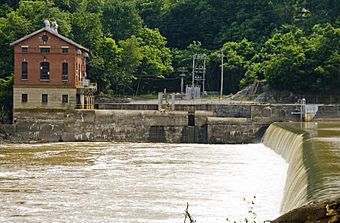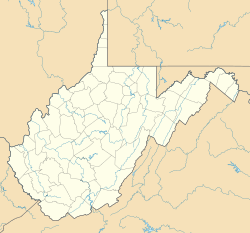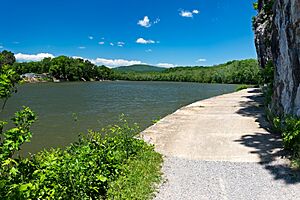Power Plant and Dam No. 5 (Potomac River) facts for kids
Quick facts for kids |
|
|
Power Plant and Dam No. 5
|
|
 |
|
| Location | Berkeley County, West Virginia / Washington County, Maryland, USA |
|---|---|
| Nearest city | Marlowe, West Virginia |
| MPS | Berkeley County MRA |
| NRHP reference No. | 80004438 |
| Added to NRHP | December 10, 1980 |
The Power Plant and Dam No. 5, also known as Honeywood Dam, is a special place on the Potomac River. It has two main parts: a dam that holds back river water and a power plant that uses this water to make electricity. The dam was first built to help the Chesapeake and Ohio Canal (C&O Canal) work. Today, the dam is part of the Chesapeake and Ohio Canal National Historical Park.
Contents
What is Dam No. 5?
Dam No. 5 was first built in 1835. Its main job was to keep enough water in the C&O Canal. This canal was like a water highway for boats carrying goods. The dam helps create a large pool of water, called a reservoir. This reservoir is about 490 acres (200 ha) big.
How the Dam Was Built
The first dam in 1835 was made of wood. Over time, it was replaced with a stronger stone structure. Later, concrete was added to make it even more solid. The dam stands about 20 feet (6.1 m) tall. In 1993, the dam was updated again to keep it working well.
The Dam During the Civil War
During the American Civil War, the dam was very important. In December 1861, soldiers from the Confederate States of America tried to destroy it. Their leader was General Stonewall Jackson. They wanted to stop coal from reaching Washington, D.C. through the canal. But their attacks did not cause much damage to the dam.
The Honeywood Power Plant
The power plant is a two-story brick building. It is located on the West Virginia side of the river. This building was first built around 1900. It started as the Honeywood paper mill. The very first Honeywood Mill was built in 1835 by Edward Colston. That mill burned down and was rebuilt. It burned again during the Civil War.
How the Power Plant Makes Electricity
Today, the power plant uses the river's flow to make hydroelectric power. This means it uses moving water to spin machines that create electricity. The power plant is run by a company called FirstEnergy. It can produce 1210 kilowatts of power. That's enough electricity for many homes!
Little Slackwater: A Tricky Spot for Boats
The water held back by Dam No. 5 created a wide, calm area. Canal boat drivers called this area "Little Slackwater." Boats would leave the narrow canal at Guard Lock #5. Then they would float freely in the river's calm water for about half a mile. After that, they would re-enter the canal at Lock 45.
This part of the journey was often tricky. If the river current was strong, it was hard to steer the boats. On May 1, 1903, a sad accident happened here. A rope broke, and a boat with people on board went over the dam. This caused injuries and some people lost their lives.
Historic Recognition
Both the dam and the power plant are important historical sites. They were added to the National Register of Historic Places in 1980. This means they are recognized for their special history and importance.
Images for kids





